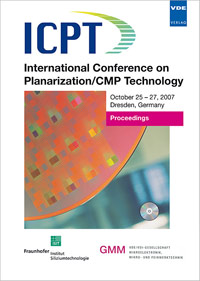Effect of Pad Hole on ECMP process
Conference: ICPT 2007 - International Conference on Planarization / CMP Technology
10/25/2007 - 10/27/2007 at Dresden, Germany
Proceedings: ICPT 2007
Pages: 5Language: englishTyp: PDF
Personal VDE Members are entitled to a 10% discount on this title
Authors:
Jeong, Sukhoon; Lee, Sangjik; Park, Jaehong; Jeong, Haedo (Department of Precision & Engineering, Pusan National University, Jangjeon-dong, Geumjeong-gu, Busan, 609-735, Korea)
Kim, Hyoungjae (Busan R&D Center, Korea institute of industrial Technology, Busan, 609-735, Korea)
Abstract:
Electrochemical mechanical planarization (ECMP) process makes copper ions dissolved electrochemically by applying an anodic potential energy on the copper surface in an aqueous electrolyte, and then copper complex layer removed by the mechanical action of polishing pad. The ECMP process allows lower pressure processing to soft Cu built on mechanically fragile low-k dielectrics, comparing to traditional Cu chemical mechanical polishing (CMP). The polishing pad used in ECMP is a conventional IC pad with holes, and has roles of supplying aqueous electrolyte to copper surface and removing copper complex layer. Material removal rate (MRR) and, uniformity are tested according to diameter and arrangement of holes opened on the polishing pad, and simulated by the change of the wafer overhang distance (WOD) from the platen and the electric contact area (ECA). In order to derive the design rule of the system, the experimental results are compared with the simulation. After ECMP process, it was verified that WIWNU was lower than 2% using the relatively uniform ECA pad (C-type) under smaller WOD which was well matched with the simulated MRR profiles.


